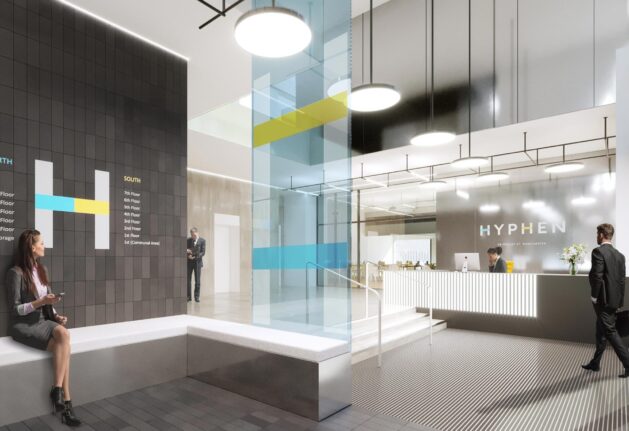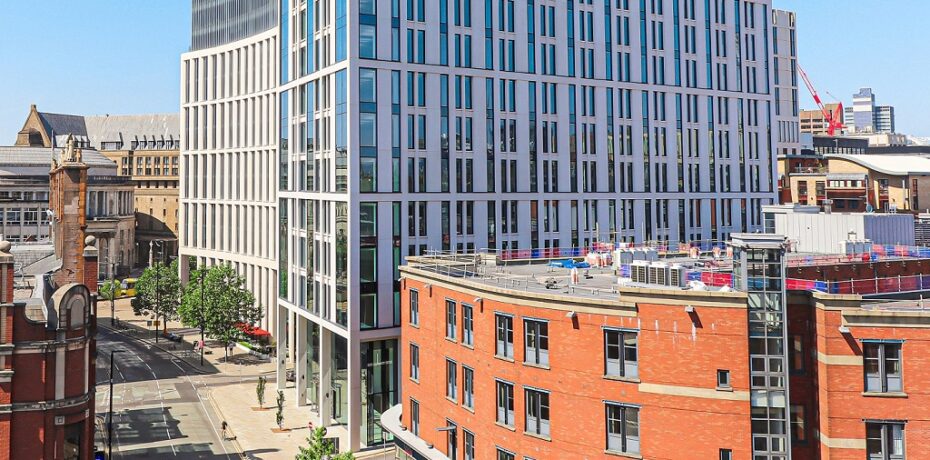The Subplot
The Subplot | Return-to-office special
Welcome to The Subplot, your regular slice of commentary on the North West business and property market from Place North West.
THIS WEEK
- Pingdemic disruption: reports of up to one in three staff self-isolating and barely half back in the office
- Pings ain’t what they used to be: Flexible office operators bide their time
- When Delta is done: one approach to the post-pingdemic office market

BAD VIBRATIONS
 Property gets the alert
Property gets the alert
The ping came last Tuesday morning. An NHS App venue alert suggested a Covid-19 risk at a popular Manchester property lunch location. This is the new pingdemic normal. How does the North West office market cope?
Tuesday was a write-off for David Lathwood. Like many others he got the post-lunch alert from the NHS app. For him the rest of the day was a rush to get tested, cancel meetings with a banker and an architect, and the scratching of plans to attend an evening reception.
No biggie?
Lathwood, formerly JLL North West chair and now chief executive of Pitalia Real Estate, is sanguine about the trouble caused by his experience of the UK’s covid pingdemic. “Everyone’s seen it before, they understand, it’s no biggie,” he says. He spent the next few days wondering how many of his fellow lunchtime diners were also pinged. “It must be half the Manchester property business,” he jokes. Lathwood was one of more than 680,000 pinged last week in England. What nobody quite knows is how seriously the Delta variant infection, the cause of the pings, is affecting local office markets.
Working from home
The good news is that despite summer holidays and Delta surges, office occupancy – the actual number of human bodies using office floorspace – seems to be rising. It is anecdotal, so treat with caution, but in one 400,000 sq ft city centre portfolio with a heavy bias to larger corporate occupiers, about 20-25% of bodies are in the building. That sounds awful but it is a good deal better than the 15-20% the same portfolio was scoring the week before, so it’s success (of a kind). Both are miles below the 75% of bodies on site you might have expected in 2019.
Even better
Office buildings with a higher proportion of local or SME occupiers are back in the office in even greater numbers. Paul Shakeshaft, head of property management at CERT Property, looks after the 30,000 sq ft Hilton House in Manchester’s Northern Quarter, and Duke & Parr at Duke Street in Liverpool. “The majority of businesses are back in work, but it’s averaging at around 50% to 60% in the office at any one time, with many businesses encouraging flexible working and a rota basis,” he says. Occupiers are aiming for a return to work in early September. Lettings are also looking better, with another 6,000 sq ft under offer at Hilton House.
But pings
Liverpool feels similar. “There seems to be a gradual increase in people occupying offices from where it was in April but the feel is that it’s about a third of pre-pandemic levels. Our own office is now almost back to 70% for four days a week,” says Keppie Massie partner Stuart Keppie. However, he adds that around 30% of staff have been self-isolating in recent weeks, indicating the extent of the disruption caused by the pingdemic.
Slowly does it
The bad news is that this number isn’t going up very fast. The public sector and big corporate occupiers, especially US-owned corporates, are in no hurry to send staff back to the office. Plenty of those who could return to work are avoiding it. Many are choosing voluntary quarantine to ensure that their pre-holiday PCR tests come back negative. Others are somewhere on the spectrum between cautious and fearful. Thousands more have been pinged by the NHS App or contacted by NHS Test and Trace.
Can you feel it?
The major office markets will certainly have noticed something. The NHS App pinged 1,300 people in Manchester in the week to 7 July, another 1,000 in both Liverpool and Salford, 900 in Trafford, 800 in Wirral, 600 in Bury, and so on. But forget the NHS App for a moment, and focus instead on NHS Test and Trace. In the six weeks to 14 July, Liverpool’s main commuter boroughs (the city, Sefton, Wirral, Cheshire West & Chester) saw 125,600 people contacted and told to isolate. In the Manchester/Salford commuting boroughs (Cheshire East, the Twin Cities, Stockport, Trafford, Tameside, Bury, Rochdale) the figure was 213,000. That’s a lot of people. You can explore a fascinating interactive map.
Economic shocks
If IHS Markit/CIPS data is any guide, the UK economy’s growth rate slowed in June, with further slowdowns likely in July and August caused by labour and supply shortages. UK GDP growth is also slackening: the economy expanded by 0.8% during May, according to the Office for National Statistics, lower than April’s 2%, and lower even than the modest expected growth rate of 1.5%. The next GDP data drop is 12 August, so we’ve not long to wait to discover if this is a blip or a trend.
Fingers crossed
The bottom line is that while hopes are high for a large return to work by October 2021, there remains a real risk this will be delayed until March 2022. Landlords and property managers are aghast at the thought. “If that happens, we have a problem,” one asset manager told Subplot. His face spoke volumes, because a delayed return to the office would push some landlords a bit further than is comfortable. It would also do untold damage to city centre amenities: without office workers they are not viable.
Diary invite
The hope is that by October, the pandemic will have morphed into endemic, and most people will have learned to trust the vaccines. At the boss-level, by October patience with working from home absenteeism may have worn out. “By autumn the productivity loss that comes from working from home will be starting to hit occupiers’ bottom lines, and that’s when they will act,” predicts David Lathwood.
Conclusion: We just don’t know.
DRIVING THE WEEK
Pings aint what they used to be
Flex workspace was supposed to be the big office market winner from the pandemic. It still might be, but as the Delta variant got going the pace of growth in the supply of North West flex scene slowed to a crawl. Here’s why.
Don’t panic, nothing dreadful is happening. Occupier demand for flexible office space isn’t at all bad, and you might (in the current context) call it good. The best guess is that, as of this morning, around 40,000 sq ft to 50,000 sq ft of potential flex-space occupier deals are in play in Manchester, and a decent chunk in Liverpool, with operators reporting a busy week of viewings ahead. New openings, like the 32,000 sq ft Hana hub at Landmark, Oxford Street, have quickly motored ahead to achieve 50% plus occupancy. Last month’s 10,300 sq ft letting to HSBC helped.
They like it fresh
“The newer stock, two or three years old, is the flex stock that’s doing well,” says Colliers’ senior surveyor (and flexi space rainmaker) Patrick Kennedy. “Now, more than ever, that is the floorspace occupiers are focusing on as they try to encourage people to return to work.” Yet flexible office operators who might provide more of that exciting new stock are turning to Birmingham, Glasgow or Edinburgh to satisfy their expansion plans. The Office Group, X+Why and Spacemade, among many others, are not hurrying into Manchester deals. What’s going on?
Nice crowded market you got there, buddy
Dan Silverman, co-founder of Spacemade, tells Subplot: “We are looking at a number of opportunities in the North West and Manchester in particular. The locations that people want to be in regional cities tend to be smaller and fewer than in larger ones – just three streets can make all the difference. So, we have been taking our time to get things right – but there are definitely opportunities in the North West.”
Discounts
The North West was first into the flexible office game, and the result is what agents and operators euphemistically described as a “healthy” stock of serviced floorspace. For “healthy” read “maybe too much.” Before the pandemic some operators resorted to handing out leaflets in the street in a bid to attract occupiers; today the same supply-side pressure is resulting in significant price discounting. National data from Savills’ Workhere flex brokerage suggests the discounts have risen from 8-10% last year to 23% this year.
Price recovery
Regional flexible workspace desk prices are recovering. Workhere said that the regional average per desk price is said to have recovered to £254, close to the £269 recorded in H1 2019 before Covid-19 came along to spoil the party. Desk prices haven’t staged anything approaching a similar recovery in London.
Room for a clever one
Kennedy says there is still scope for new operators, but only if they get everything right. That means a landlord which understands operating agreements and is up for signing one, the right kind of operating agreement, the right occupier in the right location with the right kind of floorplate. “There are operators with their eyes and ears open, carefully watching the Manchester market, but they want to get it right before they act,” Kennedy says.
And Liverpool
Liverpool remains one of the big unknowns. The occupier demographics suggest that, approached with the right kind of energy, scale and intelligence, the larger corporate occupiers could find it fertile territory. “Liverpool has seen an improvement in flexi take-up but at smaller suite sizes in general and greater emphasis on cost-saving with better common facilities,” reports Stuart Keppie of Keppie Massie.
Ping it over
The Delta pingdemic has flattened the return to work in the flex scene just as it has the traditional office market. Estimates vary but about 20-30% of bodies are said to be at desks in the busier workplaces, which looks a bit light but not desolate. A gentle recovery in contracted occupancy could grind to a halt if the end of summer does not bring a return to the workplace for the kind of businesses that use flexible offices. “A long delay in the return to the workplace to March 2022 would leave some operators vulnerable,” says Patrick Kennedy. “But for now the vacancy rate is down, occupancy is up, and desk rates are coming back. So it’s looking good.”
Conclusion: More of a pause than a crisis, and it could last a while.
IN CASE YOU MISSED IT…

When Delta is done, what comes next?
A Mosley Street Manchester office block shows a glimpse of the future. This is what the office market looks like when the Delta variant has done its thing.
Post-pandemic the balance of power in the office market will be decisively in favour of the occupiers, as even the slow-learning landlords now appreciate. In practise this may mean a lot more plug-and-play office deals as landlords learn from the WeWork revolution in flexible office space. Nobody has learned more directly, and painfully, than Boultbee Brooks. Its putative deal with WeWork for the entire 51,000 sq ft Hyphen building, Mosley Street, collapsed in 2020 after two uncertain years.
Go studio
This week, two recruitment businesses, Hunter Education (680 sq ft) and Carbon Recruitment (1,150 sq ft), have each taken fully-fitted and furnished studios at Hyphen. They pay a single monthly fee that wraps up absolutely everything except electricity. A flexible lease, with scope to customise if they want, opens the door to studios including meeting rooms, kitchen space, break-out zones and their own workstations. Interest in other studios is said to be good, to the extent that Boultbee Brooks is expanding its Studio Space concept to Leeds and Cheltenham.
The Subplot is brought to you in association with Cratus and Bruntwood Works.





